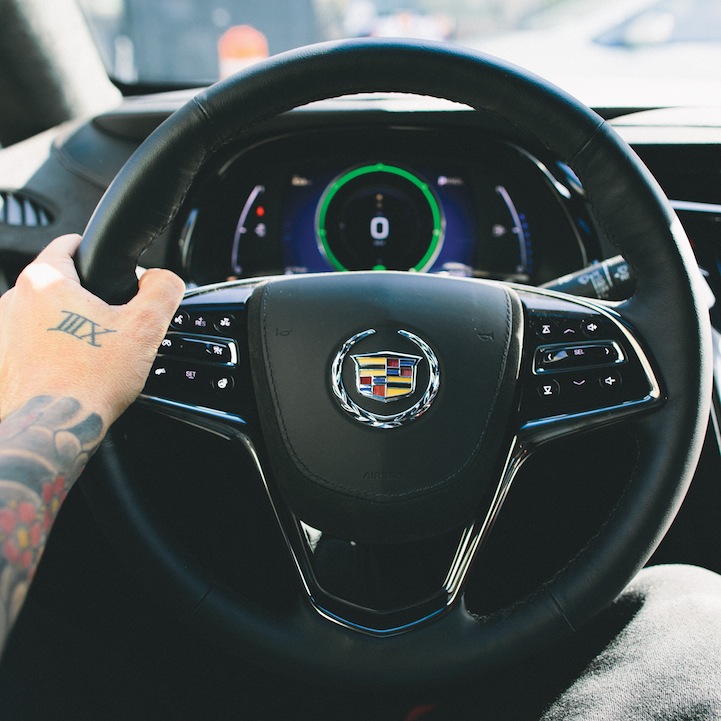This post is in partnership with Cadillac. The first ever ELR: where electricity meets luxury. Check it out here.
With 200 million active users who collectively share 60 million photos a day, Instagram isn't just a must-have photo application; it's a gigantic social network. Launched only a few years ago, in October 2010, it has quickly become the place most of us visit to share our daily lives. Now Instagram is also a place where true talent can be found. With legions of followers, its influential photographers capture their world in unique and inspiring ways.
Recently, Cadillac invited four top New York City-based photographers to view the new ELR luxury coupe through their aesthetic lenses. Called the ELR Exposure Project (#ELRExposure), the resulting pop-up photo gallery displayed the cutting-edge electric vehicle against the backdrop of New York's trendy hotspots and iconic landmarks. Using examples from the show, we present our top 10 tips on how to take Instagram photos that truly stand out.
1. Look for Symmetry and Lines

Keep in mind the square, symmetrical composition of an Instagram photo. Pay close attention to how you position your subject within the frame. Also notice the geometry of the other key elements in the photo and how those elements intersect and interact. In this Instagram image by Tim McGurr (aka 13th Witness or Instagram: @13thwitness), the vertical lines of the latticework on Grand Central Station's cathedral windows mirror the road's vertical yellow stripes. The ELR becomes the focus as it breaks up all the other symmetrical aspects of the photo.
2. Follow the Rule of Thirds

Divide the photo into an imaginary grid with two vertical lines and two horizontal lines. The key elements of the photo should be situated along those lines or at the intersections of the grid. Instead of placing your subject right in the middle, try it off to one side or toward the top or bottom. In this image, by Derrick Jones (Instagram: @djdnice), the ELR sits on the bottom horizontal line, while its wheels intersect the vertical lines.
3. Shoot from Unusual Angles

One of the benefits of a camera phone is that its small size enables you to take photos at unusual angles. The vantage point from which you shoot gives your viewer a chance to see the world from a different perspective. When in the city, try shooting a building from below by looking up or, if you dare, find a skyscraper's rooftop and shoot the skyline from high above. This image by Jonathan Mannion (Instagram: @JonathanMannion) was taken close to the ground, giving the car a whole new look and feel.
4. Experiment with Lens Accessories

Accessories that attach to your camera-phone lens will improve the quality of your photos, and expand the scope and uses of your phone's camera. Some lens attachments increase the flexibility of your depth of field while others enable you to get better wide-angle and zoom shots. If you don't have a smartphone or don't want to invest in lens attachments, you can achieve the same effect by taking a photo with your digital single lens reflex camera, using depth of field, and uploading it to Instagram. In the above image, Liz Eswein (Instagram: @newyorkcity) uses depth of field to foreground the ELR against a blurred city background. While the skyline can be made out, it's secondary to the car, which is in sharp focus.
5. Fill the Frame

Since it will likely be viewed on a phone, your photo will be more compelling if its subject fills the entire frame. In this image, Tim McGurr (Instagram: @13thwitness) zooms in on the unique instrumentation details on the ELR's steering wheel.
6. Overcome Low-Light Situations

Achieving clear, non-grainy photos in low-light situations is particularly difficult. Instagram users can make up for this with apps such as Night Cam and Slow Shutter Cam for iPhone, or Night Camera and ProCapture for Android. Of course, you can also do what Tim McGurr (Instagram: @13thwitness) did above: He accentuated certain aspects of the ELR just by taking advantage of the available light in the background.
7. Capture the Moment

Another benefit of a camera phone is that you typically have it on you at all times. Stay alert to the scene around you and you'll likely be exposed to photo opportunities you might otherwise not have noticed. In this photo, Tim McGurr (Instagram: @13thwitness) captures a perfectly timed interaction between the ELR and two bridges: the Manhattan Bridge to the left and the Brooklyn Bridge to the right.
8. Pay Special Attention to Lighting

Shadow is an intriguing compositional element, but it can also ruin a photo if it isn't taken into account. Night shadows can create a scary, surreal feeling or simply serve as a counterbalance to light. In this image, Jonathan Mannion (Instagram: @JonathanMannion) juxtaposes the ELR's shadow with its bright headlights and the bokeh (or blurred effect) of the city lights.
9. Don't Forget the Filters

Decide what mood you want to evoke and then pick your filter accordingly. A monochromatic (or black and white) filter, for instance, can make an ordinarily drab background appear more interesting by accentuating the contrast between lights and darks. But don't overdo it. You can lose the original intent and feeling if the viewer focuses too much on all the filters you used. In this image, Liz Eswein (Instagram: @newyorkcity) used a filter to transition to black at top and bottom, framing the ELR in relation to the vibrant background.
10. Pick and Choose Your Favorite Photo-Editing Apps

With so many photo apps out there, it's hard to pick the ones that will work best for you. Some popular ones these days are VSCO Cam for overall editing, Afterlight for quick editing and nice framing options, and Over, if you like adding text to your photos. In this image, by New York City native Derrick Jones (Instagram: @djdnice), the glow of the sun looks like it's been enhanced. According to Derrick, however, no filters were used. He shot the self-portrait with a Leica M240 attached to the back window of the ELR.
Which of these tips was most helpful to you?
























































































